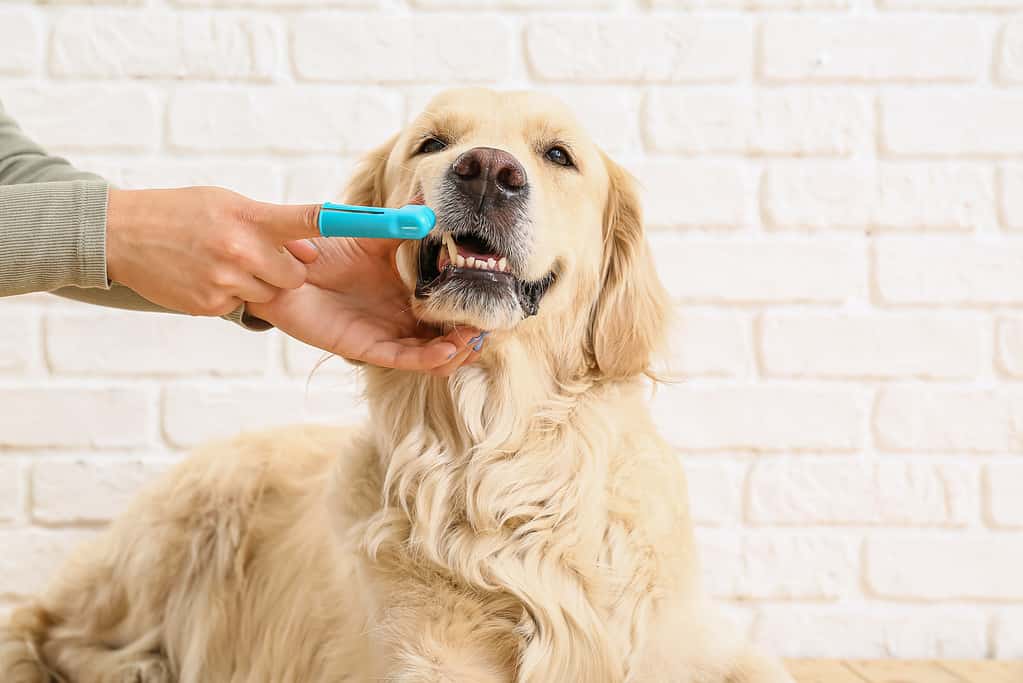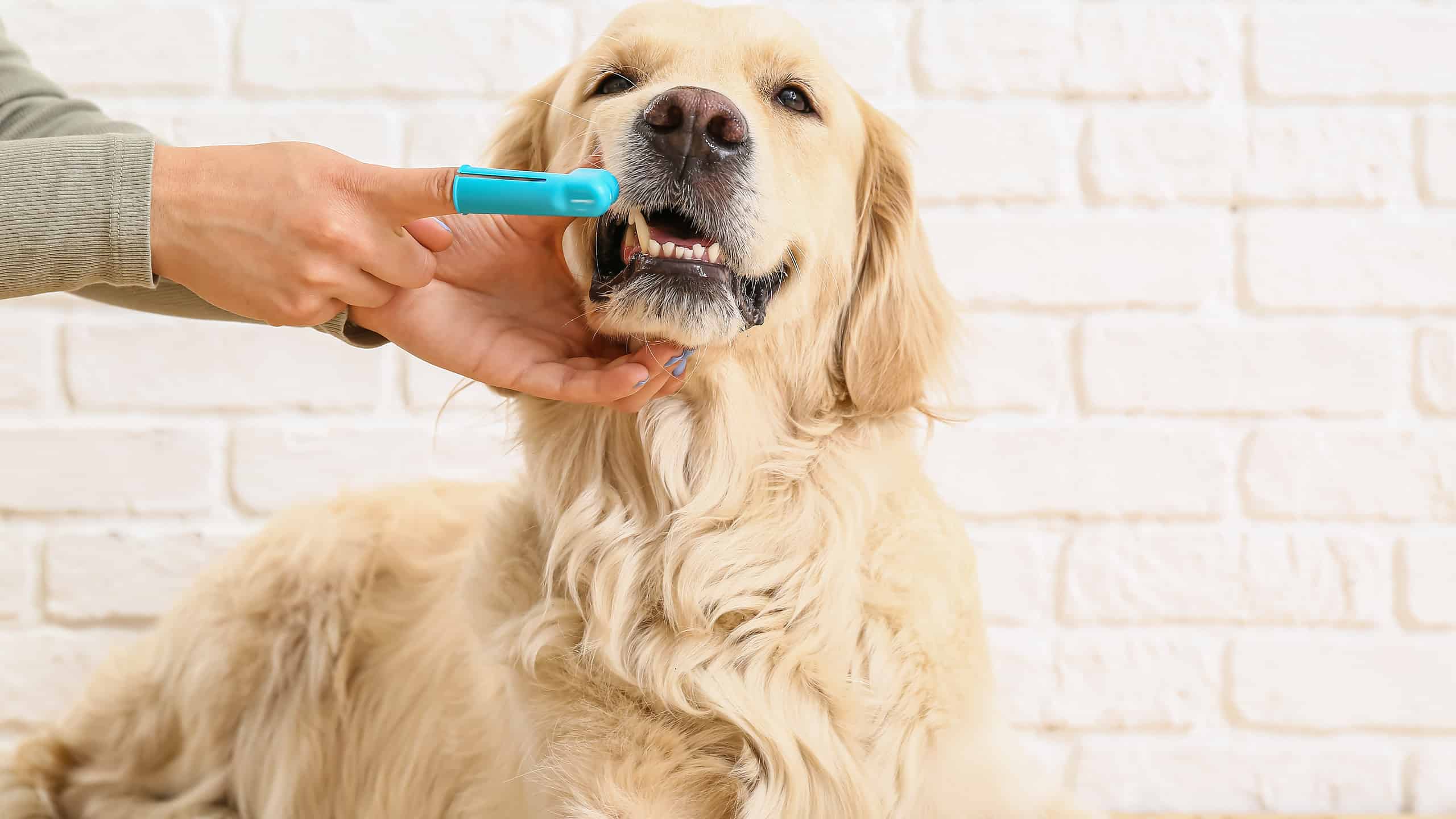Most people don’t even know that they can brush their dog’s teeth at home. It’s common not to understand how important it is to their health! As knowledge of pet care advances, we’re learning that brushing your dog’s teeth is one of the most important things you can do for their oral health and their overall health.
Feeding a healthy diet, providing plenty of chews, and using VOHC-approved dental products are a few more ways to keep up with your dog’s oral hygiene.
In this article, we’ll discuss how to brush your dog’s teeth and some other tips and tricks that’ll help you keep on top of their oral health.
How Oral Health Impacts a Dog’s Overall Health

Keeping up with your dog’s oral hygiene can benefit more than just their dental health!
©Pixel-Shot/Shutterstock.com
Poor oral health means more than bad breath. Just like in humans, dogs’ oral health can have detrimental impacts on their overall health. It can lead to or worsen several health conditions, including heart disease and diabetes.
Keeping your dog’s teeth clean is the best way to prevent dental disease, alongside routine veterinary care.
How to Brush Your Dog’s Teeth

Brushing your dog’s teeth is easy, but getting them to accept the process can be more difficult.
©Aquarius Studio/Shutterstock.com
Step #1: Gather Your Supplies
First, you’ll want to gather the right supplies to brush your dog’s teeth. These include:
- A toothbrush of your choice. Regular human toothbrushes are fine, or you can choose one made for dogs. There are dog toothbrushes that slide onto your finger, electronic toothbrushes, and double-sided ones that wrap around the entire tooth–just to name a few!
- Dog toothpaste. Never use a toothpaste made for humans on your dog, as they contain ingredients that are toxic. Instead, choose a dog toothpaste–preferably one approved by the Veterinary Oral Health Council (VOHC).
Step #2: Train Your Dog to Accept Handling
Next, train your dog to accept having their mouth handled. Some dogs may take to this more quickly than others, but here are the basic steps to desensitize them to the experience:
- Touch their snout and mouth with your hands. Start slowly, getting as close as your dog will allow and progressing from there. Your ultimate goal is to be able to open their mouth and touch their teeth, but your starting point may be giving them nose scratches from time to time as you pet their head normally.
- Introduce the toothbrush and toothpaste. Next, let your dog sniff the toothbrush and taste the toothpaste. Give them treats for interacting with them! Progress to touching their snout, then teeth, with the toothbrush.
- Introduce the brushing motion. Brushing will feel weird to dogs at first, so take this slowly. Don’t look to get a good clean yet, just to get your dog used to the experience.
- Reward for everything! Keep the experience as positive as possible by rewarding your dog with their favorite treats. Be especially generous when they make progress, even if it seems small.
Remember that this process takes time. Some dogs may allow teeth brushing right away, while others may take weeks or months.
If your dog is a bite risk, you may not be able to complete this process safely. In a case like this, it might be best for everyone involved to use alternative methods to keep their teeth clean, such as dental chews.
Step #3: Brushing their Teeth
Once your dog accepts you brushing their teeth, you can start doing it daily. Remember that it’s okay to take breaks and not brush all of their teeth at once–even a little each day is better than nothing!
You may need to brush them multiple times a day if your dog can only handle a little at a time. However, don’t stress too much about this! As you both get into a routine, it’ll likely come more easily.
7 Tips to Keep Your Dog’s Teeth Healthy
#1: Brush their Teeth Daily
The number one thing you can do for your dog’s teeth and gums is to brush their teeth every day. Just like us, dogs can quickly develop plaque and tartar in their mouths.
Daily toothbrushing isn’t feasible for some dogs, though, so don’t beat yourself up if this is the case! Luckily, there are other options that can help keep your dog’s teeth clean–they just don’t tend to do quite as well as brushing the teeth yourself.
#2: Feed a Healthy, Vet-Recommended Diet
A poor diet can harm your dog’s teeth, so be sure to feed them healthy food. Their primary diet should consist of veterinarian-recommended dog food, and treats should make up no more than 10% of their daily calories.
If your dog has a dental issue, or even if they won’t let you brush their teeth, your veterinarian may recommend a prescription dental food. These aid in keeping a dog’s teeth cleaner and help to prevent or lessen the effects of dental disease.
#3: Provide Plenty of Chew Toys

Chewing helps to remove plaque and keep a dog’s mouth cleaner.
©Valeriya Dzyuba/Shutterstock.com
Chewing is important to dogs for so many reasons! It’s an instinctual behavior that helps reduce stress, calm your dog down, and even keep their teeth clean.
The friction between chew toys and your dog’s teeth can help to rub away plaque and keep the teeth a little cleaner. The more your dog chews, the healthier their teeth are likely to be.
#4: Avoid Rawhide and Other Bones
Rawhide bones can break apart and cause a choking hazard or form an intestinal blockage. Cooked bones can splinter, causing tears in the digestive tract.
Many people instead turn to raw bones, thinking that these will be better for their pup and more natural. After all, dogs naturally have prey drives and would eat raw bones all the time if left to their own devices!
Unfortunately, though, raw bones also come with their risks. The FDA notes that raw diets, in general, can cause illness to the entire family. Even after cleaning preparation surfaces, things that your dog licks can become contaminated as well.
With things like bones, you also have to think about the flooring, dog beds, and furniture they touch. Everyone has their own risk tolerance–but personally, I avoid anything raw since it goes against veterinary recommendations.
#5: Purchase VOHC-Approved Products
The Veterinary Oral Health Council, or VOHC, lists products that are proven to reduce plaque and tartar in dogs. By sticking to these products, you’ll know that you’ve gotten your money’s worth!
Pet products are pretty unregulated, so it’s nice to have backing from a veterinary organization to ensure we’re buying things that work for our dogs.
The VOHC lists all kinds of products you can try, including:
- Dental diets
- Dental chews
- Oral sprays
- Mouth rinses
- Water additives
- Powdered food additives
- Dental wipes
These can work for any dog but are especially helpful if you can’t brush your dog’s teeth as alternative ways to keep them clean.
You can often use several in combination, though you should always read the labels and discuss them with your veterinarian.
If your dog is on any medications, some dental hygiene products may interfere with them–so checking with your vet in these cases is doubly important.
#6: Examine their Mouth Regularly
The easiest way to get into a routine is to examine your dog’s mouth while brushing their teeth. Look at their teeth, gums, and tongue to check for plaque, tartar, redness, swelling, or anything that looks out of place. Also, check how their breath smells!
If your dog’s mouth seems dirty and you can’t get it clean, it’s likely time for a professional cleaning at the vet.
If you notice symptoms of dental disease such as red, swollen gums, broken teeth, loose teeth, lumps in the mouth, bad breath, or bleeding, you should bring your dog to the vet for a check-up.
#7: Schedule Routine Dental Cleanings with Your Vet

Your veterinarian can reach areas you can’t at home, and can give your dog’s teeth a deeper clean.
©Yavdat/Shutterstock.com
Professional dental cleanings at the vet are more thorough than at-home cleanings. They include radiographs, scraping off the hardened plaque that won’t come clean with a toothbrush, and a professional gaze that may notice symptoms you miss at home.
It’s the same as the difference between you brushing your own teeth and getting a professional cleaning from your dentist.
Veterinarians will typically put a dog under anesthesia to clean their teeth, so they can also do a more thorough job due to this. They may be able to reach places in the mouth you can’t at home while your dog is awake.
Most vets recommend dental cleanings around once a year, though I’ve spoken to people who have kept their dog’s teeth so clean that their vets recommend waiting longer between appointments!
Thank you for reading! If you have feedback on this post, please contact the AZ Animals editorial team.
Ready to discover the top 10 cutest dog breeds in the entire world?
How about the fastest dogs, the largest dogs and those that are -- quite frankly -- just the kindest dogs on the planet? Each day, AZ Animals sends out lists just like this to our thousands of email subscribers. And the best part? It's FREE. Join today by entering your email below.
Thank you for reading! Have some feedback for us? Contact the AZ Animals editorial team.








